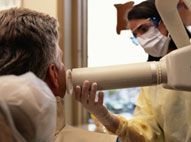 In addition to spotting cavities early, X-rays are used to examine erupting teeth, diagnose bone diseases, evaluate injury, or plan orthodontic treatment.
In addition to spotting cavities early, X-rays are used to examine erupting teeth, diagnose bone diseases, evaluate injury, or plan orthodontic treatment.
In general, children need X-rays more often than adults because their mouths grow and change rapidly. The American Academy of Pediatric Dentistry recommends X-ray examinations every six months for children with a high risk of tooth decay. Children with a low risk of tooth decay require X-rays less frequently.
X-rays provide an important tool that shows the condition of your teeth, roots, jaw, and overall facial bone composition. X-rays can reveal the exact location of impacted and unerupted teeth, the presence or degree of periodontal disease, abscesses and many abnormal growths such as cysts and tumors. X-rays also help the dentist pinpoint the exact location of cavities and other signs of disease that may not be possible to detect through a visual examination.
In most cases, new patients require a full set of mouth X-rays. Follow-up visits may require X-rays to monitor the conditions of your gums.
X-rays are critical diagnostic tools our office uses to pinpoint cavities and spot other kinds of problems or conditions not visible to the naked eye.
There are three types of radiographs (or X-rays) that are routinely taken:
- Bitewings - used to help diagnose cavities between the teeth.
- Periapical X-rays - show the entire tooth, including the root and surrounding bone. These are useful in diagnosing an abscess, impacted tooth, or bone loss from periodontal disease.
- Panoramic X-ray - a panoramic photograph that allows the dentist to see a broad view of the entire structure of the mouth, including the jaw, in a single image. Within one large film, panoramic X-rays reveal all of the upper and lower teeth and parts of the jaw. Panoramic X-rays are a very useful screening tool assessing wisdom teeth, and can reveal abnormal growths or cysts in the jaw bone.
Dentists are sensitive to your concerns about exposure to radiation from X-rays, and are trained to prescribe them when they are appropriate. State-of-the-art technology and staying abreast of the latest diagnostic advances allow us to know which procedures and X-ray films can minimize exposure to radiation.
All of the necessary precautions are taken to minimize your child's exposure to X-rays during a typical dental diagnostic procedure. Patients always wear a lead apron and thyroid collar to avoid unnecessary radiation to other parts of the body. Not everyone needs X-rays taken on a regular basis. However, some patients may need to have X-rays taken in order to address suspected problems in their teeth or tooth structures, gums, or jaw bones.
The ionizing radiation that you receive from one dental X-ray is substantially less that the radiation you receive every day in the sun. Advances in technology, such as higher-speed X-ray film and measurement devices, have made dental X-rays even safer today. This is not to say that any unnecessary radiation, even a small amount, can harm the tissues in your body. Because X-rays can diagnose certain conditions and help a condition from becoming worse; the benefit outweighs the risk.
X-ray films detect much more than cavities. For example, they often are needed to reveal erupting teeth, diagnose bone diseases, treat an injury, or plan orthodontic treatment.





